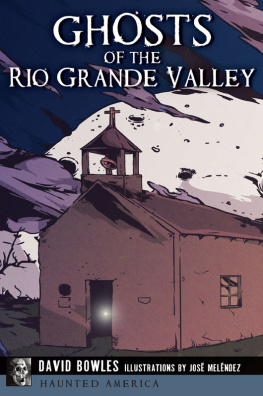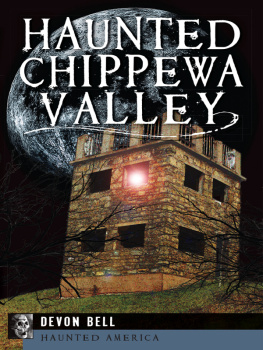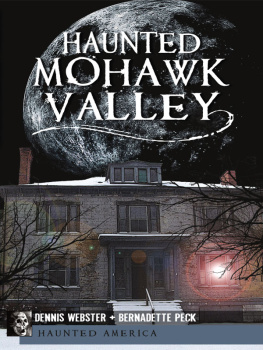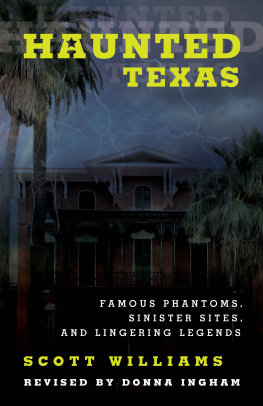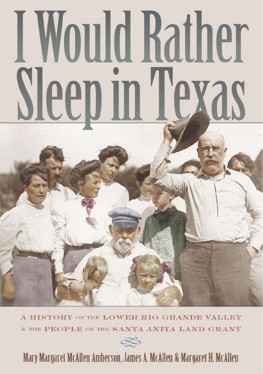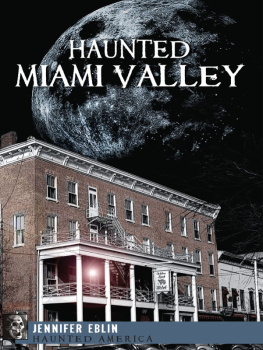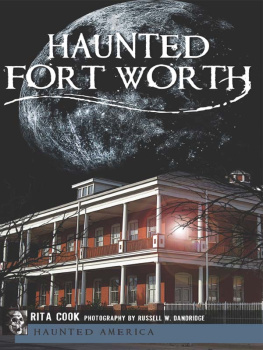


Published by Haunted America
A Division of The History Press
Charleston, SC
www.historypress.net
Copyright 2016 by David Bowles
All rights reserved
Illustrations by Jos Melndez
First published 2016
e-book edition 2016
ISBN 978.1.62585.778.1
Library of Congress Control Number: 2016938313
print edition ISBN 978.1.46711.992.4
Notice: The information in this book is true and complete to the best of our knowledge. It is offered without guarantee on the part of the author or The History Press. The author and The History Press disclaim all liability in connection with the use of this book.
All rights reserved. No part of this book may be reproduced or transmitted in any form whatsoever without prior written permission from the publisher except in the case of brief quotations embodied in critical articles and reviews.
CONTENTS
INTRODUCTION
My family has deep roots in the Rio Grande Valley, a unique area in deep South Texas that abuts the Rio Grande. Carved from Spanish land grants in the late nineteenth and early twentieth centuries by entrepreneurs and opportunists, the four-county stretch of territory boasts a unique social milieu, a mestizajeor spicy mlange, if you willof very different cultures forged together in the crucible of history.
Cameron. Willacy. Hidalgo. Starr. Each of these counties features multiple communitieswhether cities or unincorporated areaswith both their individual natures and the shared identity of which so many in this region have grown increasingly proud.
I have lived in the Valleyas we call this floodplain, dotted with oxbow lakes, thick with brushnearly my entire life, regaled since childhood with tales of witches, demons and monsters by my grandmother Garza, my parents and my various aunts and uncles, none of whom could resist scaring a little boy with tales of cucuys, boogeymen that roam the dark.
Ghosts stories were different. I didnt find them quite as terrifyingthe phantoms had been people once, after all, and I was drawn to understanding why they had lingered. What set of circumstances had resulted in their deaths? What was it about those deaths that had tethered the souls of those who should have departed to the site of their demise?
Adults didnt have answers for me. They never did, it seemed. But I could see the patterns, and I could ask the right questions.
To understand the sightings of our local ghosts, I needed to learn our history. As I grew older and more skeptical, I stopped seeing phantoms as actual, objective phenomena. But I believed in them nonetheless, saw them as the scars upon our folklore left by the traumas of the past.
So I delved deeper, discovered the untold stories of the Valleys bloody birth. Every haunting struck me as a clue, an indictment of some cosmic wrong I still struggle to tease out.
This collection, then, can be read two ways. I give you the historic context and the spectral legend. It is entirely up to you whether to take the apparitions as real or imagined.
Either way, the ghosts haunt us.
CAMERON COUNTY

PORT ISABEL LIGHTHOUSE
THE HISTORY
A picturesque town sits at the easternmost edge of Cameron County, where Texas State Highways 48 and 100 converge near the Laguna Madre, an extensive though shallow hypersaline lagoon that stretches between the Texas coast and Padre Island. Often treated as a mere gateway to the more tourist-frequented South Padre Island, this communityPort Isabelis a treasure horde of history and legend.
There are many haunted locations in the city of Port Isabel, residents affirm. The Historic Queen Isabel Inn, opened by railroad magnate Caesar Kleberg in 1906 as the Point Isabel Tarpon and Fishing Club, served as the only local hotel for two decades, becoming the focal point for some of the areas most important events, like President Warren G. Hardings last vacation before his swearing in and the yearly Rio Grande Valley Fishing Rodeo. Though several hurricanes did their best to put the hotel out of commission, it remained standing, and those who visit its stately rooms report hearing the footsteps of the dead echoing down its halls.
Those same storms sent many ships to their doom before the construction of the lighthouse. If you look out across the bay under the right sort of moonlight, the old folks will tell you, you might just see ghost ships plying the gentle waves before being lost in the early morning mist.
In 1926, the Yacht Club Hotel was built to serve the needs of the Rio Grande Valleys elite, men like land baron John Shary. The ritzy spot hosted visitors as legendary as Amelia Earhart and Al Capone; it also witnessed great tragedy, such as when a yacht burned to cinders nearby, killing a well-to-do couple visiting from New England. But like many spots along the U.S.-Mexican border, the hotel absorbed some glimmer of their souls. For to this day, visitors swear they see a young man and woman decked out in the gaudy clothes of the 1920s, chatting and laughing before fading just as one approaches to meet them.

The Port Isabel Lighthouse before full restoration. Library of Congress.
Indeed, Port Isabel has a long and variegated history. Brazos Island, just south of South Padre Island, was first settled in the eighteenth century as a series of wharves along the bayfacilitating the transportation of goods upriver past the sandbars at the mouth of the Rio Grande. The inhabitants, striking out for fresh water, found themselves in the area of present-day Port Isabel. In fact, legend has it that pirate Jean Lafitte established a fifteenfoot well just northwest of there in the early 1800s to better provide for his privateering ventures.
By the 1830s, a small community had sprung up around these water sources. It called itself El Frontn de Santa Isabel, but that name would change multiple times over the next quarter century: Punta de Santa Isabel for most of the Mexican-American War, Point Isabel with the establishment of a post office, Brazos Santiago when the Oblates of Mary Immaculate established the chapel of Our Lady by the Sea and finallyafter a horrible cholera epidemicto Port Isabel.
With the Mexican War over, Fort Polkwhich had stood at the heart of Port Isabel, providing medical care and provisions to the armywas abandoned in favor of a stronger garrison at Fort Brown to the south. By 1853, upon a mound where the fort had stood, the Port Isabel Lighthouse had been erected at last as a beacon to guide ships safely to harbor. Commerce boomed as a result, with $10 million worth of cotton passing annually through the port, even during the early years of the Civil War, when the area became a refuge for blockade runners. Such Confederate efforts shifted south to the Mexican town of Bagdad after Union forces seized or destroyed every last ship in the harbor in May 1863.
During the remainder of the war, the lighthouse was occupied intermittently by soldiers from both sides to serve as a lookout, and fresh battles were waged around its broad base. Even a month after General Robert E. Lees surrender at Appomattox, Union and Confederate troops strove with one another at Palmito Ranch, not far from the lighthouse, in the very last battle of the war. Hundreds of men had died during the long years of the conflict, joining the many others who had succumbed less than two decades earlier during the Mexican-American War. Locals whispered rumors of bodies lying in unmarked graves nearby. By the time the Rio Grande Valley Railway had connected Port Isabel to Brownsville, people were ready to turn away from the technology of the past and the deaths associated with fort, lagoon and sea.
Next page
